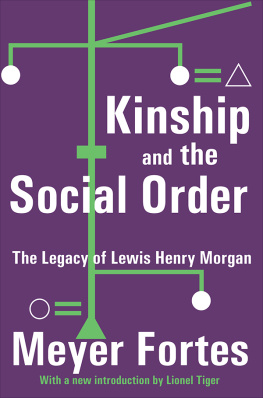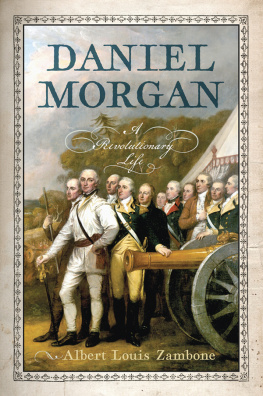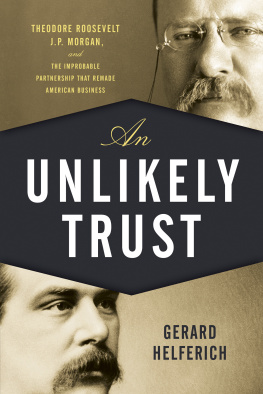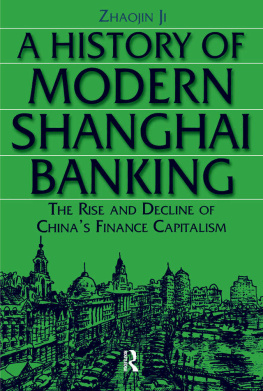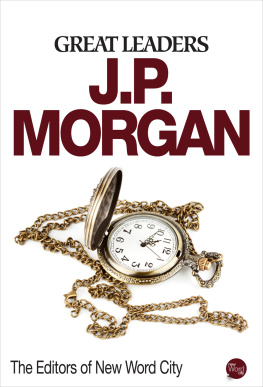Critical Acclaim for
Ron Chernows The House of Morgan,
WINNER OF THE 1990 NATIONAL BOOK AWARD FOR NON-FICTION:
The House of Morgan offers a long look at how the contemporary financial landscape came into being.... A panoramic and well-researched look at the most powerful family of banks in America over the last century... Chernow has a supple, refined style.
The Washington Post Book World
Chernow presents fresh portraits of the Morgans and the brilliant senior partners who made the bank an international powerhouse.... He dishes up enough scandal, tragedy, and intrigue for a TV miniseries.
USA Today
A brilliant, generation-spanning history of the Morgan banking empire, which offers a wealth of social and political as well as economic perspectives.... He writes in a lively, definite fashion that could make the exhaustively documented account the standard reference for specialists as well as lay readers.
Kirkus Reviews (starred review)
Entertaining and meticulously researched... pulls aside the cloak of mystery that has long surrounded this powerful American institution... that wielded far more power than most Americans ever imagined, even in their most fevered nightmares.
Dallas Times Herald
Packed with revelations, Chernows mammoth history demystifies the inner workings of the secretive Morgan banking empire.
Publishers Weekly
Brilliantly researched and written, The House of Morgan is to... Liars Poker what War and Peace is to a Judith Krantz novel.... To a potentially dry and certainly difficult subjectthe influence of high finance on modern lifeChernow brings a lively style and the endurance of a trouper.
The Wall Street Journal
Long, ambitions, but highly readable... Chernow highlights the degree to which the Morgan bank symbolized an era of Anglo-American hegemony and the growing shift of financial power from London to New York.... The book is as much about the characters of Morgan as about its history.
The Economist
Chernow vividly portrays the influence that the Morgan banks have had on the history of the Western economy since the late-eighteenth century.... Epic... An important book.
Library Journal (starred review)
Ron Chernows The House of Morgan is utterly absorbing. The study of J. P. Morgan & Co. and its offshoots is not merely the chronicle of an institution, but indeed of American finance and society. Chernow has done his research thoroughly, and written it up splendidly. A must for anyone curious as to how things have come to work the way they do.
Michael M. Thomas
Far more than the history of an American banking dynastyits the story of the evolution of modern finance... so skillfully and engagingly written, its hard to put down once begun ... Richly woven... Every page is fascinating.
Pittsburgh Press
A fabulous cast of characters, some well-known by name if not personality, others well-known only to the aficionados of wealth... This evolution of banking and companies, and the triumphs and tragedies along the way, is both a fascinating and instructive story.
Fort Worth Star-Telegram
Rich, monumental... As enchanting as an old-fashioned novel.
Entertainment Weekly
A lucid and highly entertaining account of this century and a half of transmogrification, presenting the findings from newly available archival material to capture brilliantly the inherent drama, global historical sweep, immense business, and political magnitudes, high social glamour, and, above all, moral ambiguities of the story.
America
As informative and entertaining a history, especially of the period from 1880 to 1930, as this reviewer has ever read... Nowhere has our tenuous financial system been better described than by Chernow.
Los Angeles Times Book Review
THE HOUSE OF MORGAN
An American Banking Dynasty and the Rise of Modern Finance
RON CHERNOW

For Valerie and Israel and Ruth
Copyright 1990 by Ron Chernow
Foreword 2010 by Ron Chernow
All rights reserved. No part of this book may be reproduced in any form or by any electronic or mechanical means, including information storage and retrieval systems, without permission in writing from the publisher, except by a reviewer, who may quote brief passages in a review. Scanning, uploading, and electronic distribution of this book or the facilitation of such without the permission of the publisher is prohibited. Please purchase only authorized electronic editions, and do not participate in or encourage electronic piracy of copyrighted materials. Your support of the authors rights is appreciated. Any member of educational institutions wishing to photocopy part or all of the work for classroom use, or anthology, should send inquiries to Grove/Atlantic, Inc., 841 Broadway, New York, NY 10003 or permissions@groveatlantic.com.
Excerpt from The House of Morgan: An Intimate Portrait by Herbert L. Satterlee reprinted with permission of Macmillan Publishing Company. Copyright 1939 by Herbert L. Satterlee, renewed 1967 by Mrs. Mabel Satterlee Ingalls.
Published simultaneously in Canada
Printed in the United States of America
Library of Congress Cataloging-in-Publication Data
Chernow, Ron.
The house of Morgan: an American Banking dynasty and the rise of modern finance / by Ron Chernow.
ISBN-13: 978-0-8021-4465-2
1. Morgan Guaranty Trust Company of New YorkHistory. 2. Banks and bankingUnited StatesHistory. I. Title.
HG2613.N54M6613 1990 332.12097471dc20 89-17542
DESIGN BY JOYCE C. WESTON
Grove Press
an imprint of Grove/Atlantic, Inc.
841 Broadway
New York, NY 10003
Distributed by Publishers Group West
www.groveatlantic.com
10 11 12 13 14 10 9 8 7 6 5 4 3 2 1
It is necessarily part of the business of a banker to profess a conventional respectability which is more than human. Life-long practices of this kind make them the most romantic and the least realistic of men.
John Maynard Keynes
CONTENTS
THE HOUSE OF MORGAN 20th ANNIVERSARY EDITION
Like many first books, The House of Morgan was something of a happy accident in the authors life when it was published twenty years ago. After years toiling in the vineyard of freelance magazine work, I decided to take a breather from that hectic world in the mid 1980s and landed a job in a public policy foundation called The Twentieth Century Fund, where I was put in charge of financial policy studies. During this heyday of the bull market that roared through Ronald Reagans presidency, huge numbers of people were swept into the financial world for the first time, whether as foot soldiers in investment banks or small investors dabbling in common stocks, and they had little historic perspective on the new world they inhabited.
As I dipped into the rich literature of financial history, I was struck that the old Wall Streetelite, clubby, and dominated by small, mysterious partnershipsbore scant resemblance to the universe of faceless conglomerates springing up across the globe. It dawned on me that the hordes of financial novices might be ripe for a history that would chronicle how the old Wall Street evolved into the new. A straight history, I knew, would be a tedious task for readers and do small justice to the turbulent pageant of heroes and scoundrels I was unearthing. So I posed the question: was there a single family or firm whose saga could serve as a prism through which to view the panoramic saga of Anglo-American finance? There were relatively few dynasties in financial history and, hence, few suitable candidates. Some names, such as Rothschild, had long since passed the zenith of their glory, while others had a contemporary resonance with only shallow roots in the past. Only one firm, one family, one name rather gloriously spanned the entire century and a half that I wanted to cover: J.P. Morgan. To reconstruct the Morgan story, I realized, would be a daunting enterprise, for I would have to narrate the intricate stories of four interlocking firms: J.P. Morgan and Morgan Stanley in New York, Morgan Grenfell in London, and Morgan et Compagnie in Paris.
Next page

